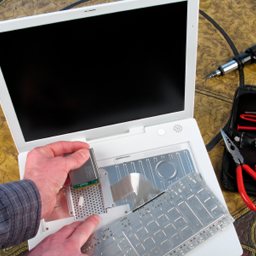Solve Your Mac Hard Drive Data Loss Problem with Easy Methods
When a computers dies due to a software failure rather than a hardware problem, its files remain inaccessible but intact on the hard drive. To recover data from the hard drive of a dead Windows, Mac, or Linux notebook, follow one of the methods below.
Method to Recover Your Data
Method One
 Get a hard drive disk enclosure. This is an external system into which you can place a computer’s hard drive in order to run it on another computer via a USB port; essentially, the enclosure will turn your laptop’s hard drive into an external hard drive. Different computers use different hard drive models, so be sure to check your dead laptop’s specifications before making this purchase. Ex. If your
Get a hard drive disk enclosure. This is an external system into which you can place a computer’s hard drive in order to run it on another computer via a USB port; essentially, the enclosure will turn your laptop’s hard drive into an external hard drive. Different computers use different hard drive models, so be sure to check your dead laptop’s specifications before making this purchase. Ex. If your
laptop has a 2.5 SATA drive, you will need a 2.5 SATA USB enclosure.
- Unless you have a SATA drive, be sure to buy a laptop-sized disk enclosure; only SATA-ready enclosures can accommodate both desktop and laptop hard drives.
- Note that disk enclosures aren’t commonly found in big-box stores and are usually purchased online.
Method Two
Borrow a working computer that is compatible with your old one. If you had a Windows, use another Windows; if you had a Mac, use another Mac; etc. (Mac lost data recovery is hard for normal users so please follow these steps so that you can recover Mac data easily.) Make sure it has enough space to accommodate the files you want to recover from the dead laptop; alternatively, you can hook a second external hard drive up to the working computer and simply use the computer as a transfer system for the files.
- A Linux computer will be able to read files off of a Windows computer (but not the other way around); unless you understand both systems, however, it is best to use a Windows computer to recover a Windows hard drive.
Method Three
Mac users can insert a Windows hard drive into their computer and be able to read (not write) the contents of their hard drive if they did not install a separate driver, for example NTFS-3G or Paragon NTFS. Take caution, though, and only use Disk Utility during the process to “mount” the hard drive. Any other action you make on Disk Utility may remove contents.
Method Four
 Remove the hard drive from the dead laptop. Turn off the laptop, unplug it, and remove the battery. Turn it over and you’ll see that various sections of the laptop base can be unscrewed and removed separately. Either look up your laptop model online to see exactly where the hard drive sits or simply look for the most likely candidate: though it differs between laptops, a laptop hard drive is often similar in size and shape to a 3.5-inch floppy disk. Unscrew the hard drive cover and remove the hard drive. Some models will pop upwards, some will slide outwards, etc.
Remove the hard drive from the dead laptop. Turn off the laptop, unplug it, and remove the battery. Turn it over and you’ll see that various sections of the laptop base can be unscrewed and removed separately. Either look up your laptop model online to see exactly where the hard drive sits or simply look for the most likely candidate: though it differs between laptops, a laptop hard drive is often similar in size and shape to a 3.5-inch floppy disk. Unscrew the hard drive cover and remove the hard drive. Some models will pop upwards, some will slide outwards, etc.
Then you can start to consider to backup or recover your data to avoid the data loss problem. In my opinion, uFlysoft Data Recovery is one good choice for you to try to recover your lost data. But no matter how best the software you are using to recover your data, due to some unexpected reasons there are some files may be gone forever. So remember this: Build a backup for your data is very important thing you need to do.
More Notes
1. To protect your data, when you finished recovery process, please use another storage device which has enough space to store your recovered data to avoid the data overwritten situation. (Our uFlysoft studio software will warn you when you do the operation to save the recovered data on the same drive which your files were lost from.)
2. As I said above, build a backup. You can use a external drive, Cloud service, etc to back up your files. Keep your data away from data loss. Or you may check this to see more details about backup info.
